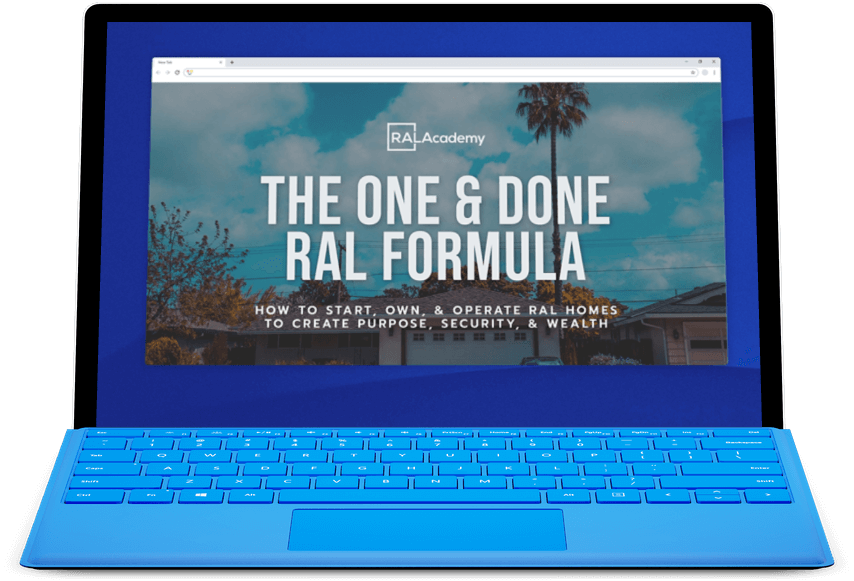Recently, Gene had the chance to sit down with Hal Cranmer, the owner and operator of A Paradise for Parents Assisted Living Homes in Arizona, who came through the RAL Academy training four years ago. After the training, Hal got started right away and purchased an existing RAL home and business and has since gone on to open four more assisted living homes in his local area.
As part of the early crop of students at the RAL Academy, Hal joined our community before we had set in place all of the extensive support, follow-up and extras that we now offer to our students. Although he has been able to keep in communication with Gene and our RAL experts and apply what he learned from them, there is an extensive amount of insight into the assisted living industry that Hal gleaned through personal experience.

His commitment to offering superior care to local seniors has afforded him the opportunity to turn one RAL home into a thriving Residential Assisted Living business with five homes and secure a bright future for he and his family.
Of the many lessons that Hal has learned along the way, one of the more important ones that he wanted to pass on to other students is the importance of the business partner relationship and how to navigate it effectively. Partnering with another individual or organization can be a great way to secure the funding for a brand new or newly acquired RAL home and business, but it also comes with a set of challenges that may not be readily apparent if it is your first time with a business partner.
In Hal’s case, he found partners who had the money to invest in his first RAL home. They had just sold a property and were looking to do a 1031 exchange, which allows an investor to sell a property, reinvest the proceeds in a new property, and defer all of the capital gains taxes.
After a few years of working with these out-of-state partners it became apparent that running the RAL home would be easier if he was able to make all of the decisions without deliberation and oversite. After all, Hal was the hands-on manager and knew exactly what was needed and was in the best position to immediately react to decisions that were in the best interest of his residents. Another important tip that Hal would pass on to students new to assisted living:
“When starting out with a business partner do your due diligence. Write everything out.”
Hal Cranmer
Make sure you are all on the same page and in agreement over all of the terms. From Hal’s personal experience, he can attest that partnerships have their difficulties. For example, unless everyone understands how the profits are structured and what the liability and exposure are if things don’t go how everyone expects, the business relationship can be strained and create more obstacles than necessary.
Hal also suggests not to make a percentage of profits agreement, because what your partners think are profits after expenses may not be the actual profits, especially when unforeseen expenses arise, like a leaky roof or a refrigerator that stops working. So, it may be better for all involved to settle on a fixed monthly return for your business partners. This way everyone knows exactly what is expected.
Another key component in establishing business partnerships is going through the 94 questions you want to ask someone before you partner with them in any business. This is a tool that had not yet been developed when Hal initially went through the RAL Academy training, but it is something that we go through with our students now. It is an invaluable tool to help create a healthy working relationship with your business partner and you will be glad that you address all those questions up front, before things potentially get more difficult and everyone’s assets are on the line.

Business partners can be great if you find the right fit for you, but as Gene often encourages students, you need to be very careful when looking to establish those partnerships. Gene’s personal advice is to:
“Only partner if you need to…if they have something you need and you can’t just hire them for it.”
Gene Guarino
In Hal’s case, with the first home and business he purchased he is currently in the process of buying out his original partners and refinancing the loan. In addition, he found a healthy partnership with his parents, who are silent financial partners. They agreed on a fixed return and interest rate, so it is more like a debt than an equity payment. He sends a check every month, they’re happy and they don’t question how he runs his RAL homes. It’s a win-win for everyone.
As far as the financing, of his five RAL homes, Hal owns one outright and he is currently restructuring his other assets with a bank, using separate loans for each of his real estate properties and another loan for the combined businesses of all of his RAL homes, thereby lowering his interest rates on the real estate portion.
This is another area where you will want to do your due diligence, because a little extra time researching financing tools and loan options can end up saving you thousands, and who doesn’t want that? Also, once you do start lining things up for your new RAL, run the numbers by someone who has been there. For example, the professionals at the RAL Academy have decades of experience with this and are here to help. As Hal reminds us, “this isn’t a real estate rental property; this is a business. So put together a business plan and then run it by someone who has done this.”
One thing to keep in mind when building your financial plan is that business loans are traditionally much shorter than the loan on the real estate, and you will need to factor in those numbers up front. For example, with Hal, his business loan has a five-year amortization, so as you are setting up your RAL homes, do your homework on the finances and know if you are going to have the cash flow for that part, because as Hal describes:
“It will be tight for five years,” but then after five years the business loan is paid off, and “it’s going to be a cash cow after that.”
Gene Guarino
Another useful tip as you navigate the financials is that the bank often wants to see a resume. They want to see someone in the deal with experience in a field related in some way to assisted living. This is especially important for new students in the RAL Academy or anyone stepping into the Assisted Living space for the first time. So if, for example, you happen to be a nurse or a doctor, or if you have business experience in a field akin to assisted living, you will be fine. Otherwise, you might consider partnering with someone who has some experience, or possibly, the qualified manager that you hire to run the home, you can use their credentials and resume to submit to the banks or lenders. Either way, the experience doesn’t need to be vast, for example, Hal was eventually able to apply for an SBA loan with only 6 months of prior experience in Residential Assisted Living.
When setting up your RAL home, another important element to consider is resident payment. Knowing which payment types are available to your prospective residents and which ones you will focus on is key. One of the tips that the RAL Academy teaches to set you on your way to success is to aim for private pay with your incoming residents. We realize that this is not always possible, as you may often get referrals from placement agents dealing in Medicare, Medicaid, or other compensation plans.
In Arizona, where Hal runs his homes, Medicaid is known as Arizona Long Term Care System (ALTCS) and Hal has found a way to make the most of that system by partnering with a research organization that incentivizes the best and most effective assisted living facilities. This organization is gathering data about assisted living care and the rate of resident admittance into hospitals for chronic conditions, injuries, and other medical issues.
Medicaid and Medicare have seen better days and with the coming influx of baby boomers entering their twilight years, the government recognizes that the financial expense is soon going to outweigh available funding. One of the ways to tackle this issue is to incentivize care homes to go above and beyond in keeping their residents healthier and out of hospitals. So, one way this works is that health insurance companies connected to Hal’s residents pay his assisted living homes an extra $30 per day per resident above their normal level of pay for all residents who remain healthy and out of hospitals.
This is a wonderful way Hal has found to help increase his RAL’s cash flow. Additionally, he has chosen to use the added funding wisely, by incentivizing his care givers. He affords them bonuses and more overtime, thereby securing their work excellence and loyalty to the care homes, and because of this he sees very little employee turnover. He has also found that with the ALTCS program, there is no need for referral fees, establishing a great reputation with the placement agents, and whenever he does lose a resident he simply needs to contact ALTCS and they find residents for him. This also means that less money and effort need to go into marketing his homes.
So do yourself a favor and check out the Medicare and Medicaid systems in your state and investigate to see if there are insurance programs that will incentivize you to partner with them in creating a healthier and more stable assisted living environment in your homes.
Also, it is worth noting that residents with lower assistance needs might receive less compensation from their insurance plan or from the state, thereby affording less income for your RAL home. But that isn’t necessarily a bad thing, as it could mean that even though your RAL might be taking in less money, if the residents don’t need higher levels of assistance, you can employ fewer care givers, which will lower your overhead. There are so many ways to structure your assisted living homes and you really need to do your homework and team up with people who have plenty of experience with assisted living.
The bottom line…this can be a challenging business, but it is also a very rewarding one and quite a lucrative one if you use the tools that are available to you. As Hal can attest, “It’s a great business that makes you feel tremendously proud of what you are doing.”
We couldn’t be more proud of Hal. We are so excited about the success of his five RAL homes and we would love to help you find similar success. We hope you’ve found this content helpful and if you have more questions check out our other online resources:
https://www.youtube.com/user/Yoitsmetv/videos
And be sure to check out our extensive training programs designed to help you get started or continue your already successful journey in this rewarding industry.
Why choose to get trained by our talented experts at the RAL Academy?
Gene, the founder and president of RALAcademy.com, has dedicated tens of thousands of hours to researching and developing strategies for investing in the senior living market and he has a passion for helping people just like you capitalize on this mega-trend opportunity. Take advantage of his hard work and learn what things can help you succeed in this rewarding industry.
Take control of your future! Come to the Live 3-Day Training held in Phoenix. We’d love to help you get started in Residential Assisted Living Homes and become a success story like Hal.




